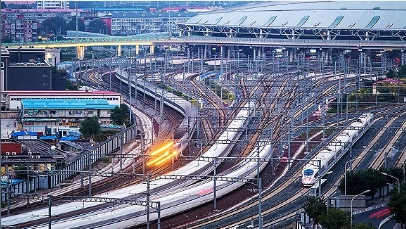The Chinese government has prepared for its
ambitious plan of railway construction. According to National Development and
Reform Commission (NDRC), up to the year of 2020, the mileage of the network of
China's high-speed rail will come up to 150,000 kilometers.

With the aiding of various financing
channels including financial funds, funds of railway construction, and bonds,
China has achieved extraordinary success during the past decade. According to
NDRC, the total mileage of the operating railway across China was 121,000 kilometers
by the end of 2015, which, with the yearly growth rate of 5.13%, increased by
about 60% compared with that of 2006.
In accordance with the general goal of
achieving the total mileage of 150,000 kilometers by the year of 2020, the
construction would have to keep in the yearly growth rate of 4.4% in the next
few years.
According to the railway construction plan,
there would form a railway network consists of eight vertical routes together
with eight horizontal routes across the mainland China. The current problems of
incomplete layout of railway network, low operating efficiency, and prominent
structural contradictions would be greatly relieved after the plan has been
fulfilled.
The key of this magnificent plan lies in
constructing high-speed railway. By the year of 2020, the newly increased rail
mileage would amount to 29,000 kilometers, among which 40%, that is 11,000 kilometers,
would be contributed by the high-speed railway. As a matter of fact, there has
been a huge supply gap in passenger railway in China, especially among the days
of festivals and holidays, so generally speaking, this plan quite accords with
the current situation. With its high speed, comfortable service, and
punctuality, high-speed rail has been the first choice for many people,
including those who lived in the traffic-convenient east coast regions.
Although the NDRC has not released the
specific amount of the investment on this enormous railway constructing plan,
we can make an estimate based on the existing statistics. At present, the Chinese
government invested about RMB800 billion in the railway construction each year,
that means RMB4 trillion in total would be invested in the construction by 2020
(including the year of 2016).
Besides, the NDRC together with the
Ministry of Transport formulated Three-Year Plan on the Construction of
Infrastructure and Major Engineering (hereunder referred as Three-Year Plan).
And in this plan, it is clearly stated that the government would invest RMB4.7
trillion on 303 projects including the construction of railway, highway,
waterway, airport, and urban railway.
The plan of investing posed great pressure
on the central fiscal revenue. The NDRC hoped that social capital would take
part in the railway construction. China's private investment plummeted since
December last year, and the growth rate of the private investment was only 2.8%
up to the June 2016.
The Chinese government wanted to activate
the private investment with the help of the railway construction plan. The NDRC
issued the Suggestions on the
Implementation of Further Encouraging and Enlarging the Social Investment on
Railway Construction on July 2015, according to which the government
decided to delegate part of the ownership of the railway and the right of operation
to lower level and some social capitals, carry forward the
Public-Private-Partnership (PPP) and equity transfer, and issue the funds of
railway development, so as to attract private investment into this field.
However, according to what was released
afterwards, the central government would just delegate the ownership and the
right of operation of the interurban railway, urban railway, railway that
mainly serve for resource exploitation, and the branch railway, which have
relatively low earnings, to the local government and social capitals; while for
those profitable mainline railway, the ownership and the right of operation
would remain in the hand of central government.
Anyhow, this plan, at least, enables to
provide China's economy with the impetus of demand-side. What's more, it is
also benefit for relieving the pressure of some industry with excess capacity
as the huge plan of railway construction needs a huge amount of raw materials
including steel and cement.
*The
article is edited and translated by CCM. The original version comes from
Jiemian.com.
About CCM:
CCM is the leading market intelligence
provider for China's agriculture, chemicals, food & ingredients and life
science markets. Founded in 2001, CCM offers a range of data and content
solutions, from price and trade data to industry newsletters and customized
market research reports. Our clients include Monsanto, DuPont, Shell, Bayer,
and Syngenta. CCM is a brand of Kcomber Inc.
For more information about CCM, please
visit www.cnchemicals.com or get in touch with us
directly by emailing econtact@cnchemicals.com or
calling +86-20-37616606.